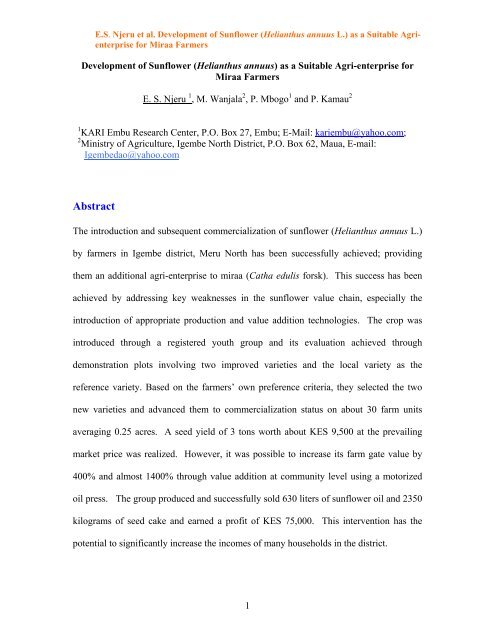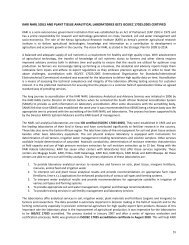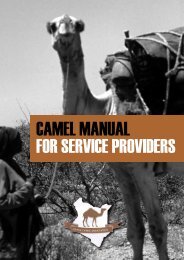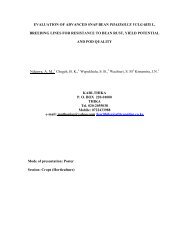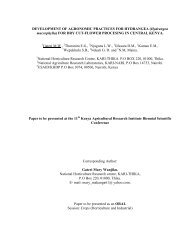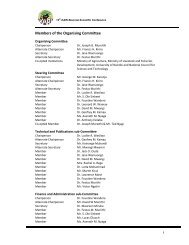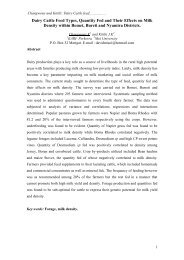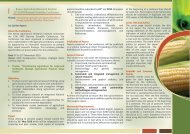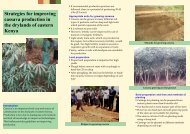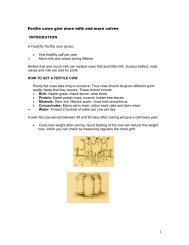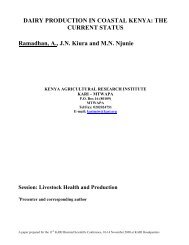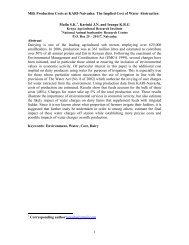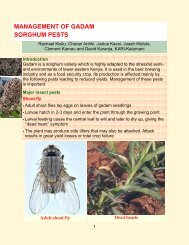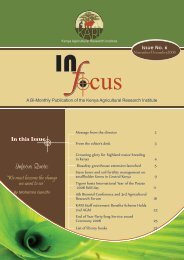Abstract - Kenya Agricultural Research Institute
Abstract - Kenya Agricultural Research Institute
Abstract - Kenya Agricultural Research Institute
Create successful ePaper yourself
Turn your PDF publications into a flip-book with our unique Google optimized e-Paper software.
E.S. Njeru et al. Development of Sunflower (Helianthus annuus L.) as a Suitable Agrienterprise<br />
for Miraa Farmers<br />
Development of Sunflower (Helianthus annuus) as a Suitable Agri-enterprise for<br />
Miraa Farmers<br />
E. S. Njeru 1 , M. Wanjala 2 , P. Mbogo 1 and P. Kamau 2<br />
1 KARI Embu <strong>Research</strong> Center, P.O. Box 27, Embu; E-Mail: kariembu@yahoo.com;<br />
2 Ministry of Agriculture, Igembe North District, P.O. Box 62, Maua, E-mail:<br />
Igembedao@yahoo.com<br />
<strong>Abstract</strong><br />
The introduction and subsequent commercialization of sunflower (Helianthus annuus L.)<br />
by farmers in Igembe district, Meru North has been successfully achieved; providing<br />
them an additional agri-enterprise to miraa (Catha edulis forsk). This success has been<br />
achieved by addressing key weaknesses in the sunflower value chain, especially the<br />
introduction of appropriate production and value addition technologies. The crop was<br />
introduced through a registered youth group and its evaluation achieved through<br />
demonstration plots involving two improved varieties and the local variety as the<br />
reference variety. Based on the farmers’ own preference criteria, they selected the two<br />
new varieties and advanced them to commercialization status on about 30 farm units<br />
averaging 0.25 acres. A seed yield of 3 tons worth about KES 9,500 at the prevailing<br />
market price was realized. However, it was possible to increase its farm gate value by<br />
400% and almost 1400% through value addition at community level using a motorized<br />
oil press. The group produced and successfully sold 630 liters of sunflower oil and 2350<br />
kilograms of seed cake and earned a profit of KES 75,000. This intervention has the<br />
potential to significantly increase the incomes of many households in the district.<br />
1
E.S. Njeru et al. Development of Sunflower (Helianthus annuus L.) as a Suitable Agrienterprise<br />
for Miraa Farmers<br />
Introduction<br />
Igembe district is situated in the northernmost part of the greater Meru region. The main<br />
cash crop is Miraa (Catha edulis forsk), an evergreen tree grown for its leaves, which are<br />
chewed for their stimulant effects (Nacada, 2006). Miraa production and trade is a multimillion<br />
shilling industry in the district. The other major crops are maize, beans and<br />
pigeon peas; which are all grown for subsistence purposes. Despite the large cash<br />
turnover from miraa, there is little evidence of its contribution to the physical and social<br />
development in the area. Indeed, the crop is associated with many negative social and<br />
health impacts on its users and contrary to popular belief, the crop does not benefit most<br />
smallholder farmers because its trade is dominated by middlemen (Belew et al., 2000;<br />
Aden et al., 2006; WHO, 2006). Moreover, many farmers, especially those with a strong<br />
religious inclination, do not grow the crop because of the negative effects associated with<br />
it (Nacada, 2006). This category of farmers would greatly benefit from the introduction<br />
of an alternative cash crop.<br />
The ministry of Agriculture is promoting alternative cash crops in its efforts towards the<br />
commercialization of Agriculture in the district (MOA, 2005). Sunflower (Helianthus<br />
annuus L.) fits well in this scheme because it is easily adaptable into various farming<br />
systems prevailing in the district, especially because of favourable climatic and soil<br />
conditions (Jaetzold et al., 2006) and also due to the fact that it may be intercropped with<br />
common crops, including miraa. It also has great potential to reduce household savings<br />
on edible oil and contribute in the development of biofuels which is becoming<br />
increasingly important in view of the escalating costs of fossil fuels. A thriving local<br />
sunflower industry has the potential to significantly reduce the national edible oil<br />
2
E.S. Njeru et al. Development of Sunflower (Helianthus annuus L.) as a Suitable Agrienterprise<br />
for Miraa Farmers<br />
importation bill, which is currently over KES 17 billion annually (Oil world, 1999;<br />
Chinchilla, 2004). Sunflower attracts many bees foraging for nectar during the flowering<br />
phase. The seed cake obtained during oil extraction is also a popular ingredient in<br />
commercial formulations of many livestock feeds as a source of energy and proteins. A<br />
vibrant local sunflower industry is therefore likely to spawn the development of high<br />
value secondary industries such as honey and animal feed manufacturing (Mielke, 2000).<br />
Despite its potential contribution in meeting <strong>Kenya</strong>’s development goals, sunflower is not<br />
produced on a large scale in <strong>Kenya</strong> largely because of lack of favourable markets. The<br />
prices offered for seed are too low to attract serious producers. The average market price<br />
for sunflower seed in the Meru region is KES 3.00/kg when buyers become available,<br />
while Bidco oil refineries offers KES 16.00/kg of seed delivered to their Nakuru factory.<br />
In addition to a weak market there are other weak links in the crop’s value chain, which<br />
include low yielding varieties, low viability of commercially available seed and lack of<br />
value addition skills (MOA, 2005). The overall objective of this project was to develop a<br />
sustainable sunflower-based agri-business in the district by addressing key weaknesses in<br />
the crop’s value chain. The specific objectives were to introduce and evaluate the<br />
potential of sunflower as a cash crop in the district; and to build the capacity of farmers in<br />
production, value-addition and marketing of sunflower.<br />
Materials and Methods<br />
The project Area<br />
The work was carried out at Kiutine village, Kawiru sub-location of Ndoleli division;<br />
situated about 25 kilometers northwest of Maua town. The area falls within the lower<br />
3
E.S. Njeru et al. Development of Sunflower (Helianthus annuus L.) as a Suitable Agrienterprise<br />
for Miraa Farmers<br />
midland (LM) 3 agro-ecological zone, which is considered marginal for most crops due<br />
to low annual rainfall and high temperatures. The only cash crop in the area is miraa,<br />
while maize, beans and pigeon peas are the major food crops. The area is therefore<br />
suitable for the introduction of additional cash crops since many farmers do not grow<br />
miraa (MOA, 2005). Miraa may be grown as a sole crop or intercropped with the food<br />
crops, making sunflower a suitable additional cash crop since the agro-ecology of the<br />
area is suitable for its production. The project chose one of the active registered groups<br />
“Mwangaza Kiutine Youth Group” as the entry point for the introduction of the crop.<br />
The group has an active membership of 25 individuals, 11 of whom are female while the<br />
rest are male.<br />
Crop Introduction and Varietal Evaluation<br />
Two high oil producing sunflower varieties, Hybrid 8998 and <strong>Kenya</strong> Fedha (openpollinated)<br />
were introduced and evaluated alongside a local variety that is commonly<br />
grown in the Meru region. The trial was laid out in a randomized complete block design<br />
(RCBD) with three replicates. The varieties were grown in 10 m x 10 m plots at a<br />
spacing of 75cm x 30cm. DAP (18%N: 46%P: 0%K) fertilizer was applied at the rate of<br />
150 kg/ha during planting. The plots were weeded after one month and top-dressed using<br />
CAN (26% N) at the rate of 100 kg per hectare. The crop was evaluated during the 2006<br />
long rain and 2007 short rain seasons using the farmer field school (FFS) approach.<br />
The group members were involved in a participatory manner in all activities including<br />
planning, planting, routine management, variety assessment and selection. The criteria for<br />
varietal selection were also determined by the farmers. These included plant height at<br />
4
E.S. Njeru et al. Development of Sunflower (Helianthus annuus L.) as a Suitable Agrienterprise<br />
for Miraa Farmers<br />
flowering, head size at full maturity, seed yield and oil yield per plot. Oil yield was<br />
determined from five one-kilogram seed samples from which it was extracted with the<br />
aid of a motorized oil press.<br />
Commercialization and Value Addition<br />
The selected varieties were advanced to commercialization status during the 2007 short<br />
rain season. Each of the group members and another 5 willing farmers were given 1 kg<br />
of highly viable seed. <strong>Kenya</strong> Fedha seed was given to 15 members while the rest<br />
received hybrid seed. The seed was subsequently processed using a motorized oil press<br />
which was hired at the cost of KES 20/litre of oil processed. The oil was then packed in<br />
one-litre plastic bottles while the seed cake in polyurethane bags weighing 75 kg each.<br />
Results<br />
Varietal Selection<br />
Crop performance during the 2006 short rain season was satisfactory due to adequate<br />
rainfall. Crop performance was, however, poor during the following season due to very<br />
low rainfall, resulting in near-crop-failure. All varieties flowered before attaining a<br />
height of one meter during the season. The resultant data was therefore disregarded<br />
because it was not reflective of the crop’s performance potential. The results of the first<br />
season trial are shown in Table 1.<br />
There was no significant (p
E.S. Njeru et al. Development of Sunflower (Helianthus annuus L.) as a Suitable Agrienterprise<br />
for Miraa Farmers<br />
improved varieties. However, the two improved varieties were not significantly different<br />
in regard to the two performance attributes. The local variety also had a significantly<br />
lower oil content compared to the other varieties.<br />
Consequently, the farmers selected<br />
the hybrid and <strong>Kenya</strong> Fedha for commercialization.<br />
Table 1: Mean performance of sunflower varieties at Kiutine during 2006 long rains<br />
Variety<br />
Plant height<br />
(m)<br />
Head<br />
Diameter<br />
(cm)<br />
Seed Yield<br />
(kg/plot)<br />
Oil content<br />
(litres/kg)<br />
Local 2.1a 9.5b 9.3b 0.06c<br />
<strong>Kenya</strong> Fedha 2.0a 19.9a 24.5a 0.18b<br />
Hybrid 8998 2.2a 19.5a 30.8a 0.29a<br />
LSD (0.05) 0.12 6.05 5.43 0.02<br />
Means in the same column followed by the same letter are not statistically different<br />
Commercialization and Value addition<br />
The farmers abandoned the local variety in favour of the new varieties on the basis of of<br />
their superior qualities. The two were grown by 30 farmers mainly in intercrops with<br />
miraa and common food crops. A total of 3150 kg of seed was produced, which was<br />
subsequently purchased by the group on a cash-on-delivery basis at a preset price of KES<br />
I5, thereby earning the farmers a total of KES 47,250. The seed yielded 630 litres of oil<br />
and 2350 kg of seed cake after processing. These were sold locally at the price of KES<br />
150 per litre and KES 20 per kilogramme, for oil and seed cake, respectively, earning<br />
the group a profit of KES 75,000 within a week after processing. Table 2 shows the<br />
effect of improved producer prices on household earnings, while Table 3 shows the<br />
6
E.S. Njeru et al. Development of Sunflower (Helianthus annuus L.) as a Suitable Agrienterprise<br />
for Miraa Farmers<br />
additional benefits that accrued at community level as a result of adding value to this<br />
seed.<br />
Discussion<br />
The results show that by empowering farmers’ groups to produce and add value to<br />
sunflower, it was possible to determine a favourable seed price which improved producer<br />
prices by 400% above the prevailing market price. The net earnings were also better<br />
from the group compared to that of the commercial oil processor, which eventually yields<br />
over 50% lower returns due to additional handling and transportation costs. The results<br />
also show that value addition increased the value of the farmers’ seed by approximately<br />
1400% based on the prevailing local market value of the seed. However, after increasing<br />
the producer price of seed by 400% the group was still able to improve the value of the<br />
purchased seed by 200% through value addition and earn a net return KES 75,000.<br />
The overall monetary benefit of this initiative to the community during the 2007 short<br />
rain season alone was approximately KES 190,000, being proceeds from seed, oil and<br />
seed cake. This has created farmer’s awareness of the fact that sunflower is a suitable<br />
cash crop for the area as it has enormous potential to improve incomes at both household<br />
and community-levels. Consequently, the group is currently scaling-up production and<br />
is in the process of acquiring its own processing equipment and premises. Finally, the<br />
crop has the potential to evolve into a major contributor to the industrialization and<br />
employment creation in this district in line with the current national policy framework<br />
(GOK, 2002; GOK, 2003; GOK, 2007).<br />
7
E.S. Njeru et al. Development of Sunflower (Helianthus annuus L.) as a Suitable Agrienterprise<br />
for Miraa Farmers<br />
Conclusions<br />
The introduction of sunflower as a suitable agri-enterprise in Igembe district has been<br />
successfully achieved by addressing the key value chain weaknesses for this crop,<br />
especially the introduction of appropriate production and value addition technologies.<br />
The project has also significantly empowered the Igembe community to develop a<br />
sustainable sunflower industry by linking the community with key stakeholders.<br />
Recommendations and Way Forward<br />
The group requires further support in product packaging, branding, standardization,<br />
diversification and development of better marketing skills for improved market access.<br />
It has been linked to key enterprise-support initiatives by this project in order to facilitate<br />
sustainable commercialization.<br />
Acknowledgement<br />
The authors wish to thank the Director-KARI for financial support. We are also grateful<br />
to the Centre Director KARI-Embu and the District <strong>Agricultural</strong> Officer, Igembe for<br />
logistical facilitation. Special tributes go to all the participating farmers for their<br />
contribution towards the success of this initiative.<br />
References<br />
Aden, A., Dimba, E., Ndolo, U. and Chindia, M. 2006. Socio-economic effects of khat<br />
chewing in north eastern <strong>Kenya</strong>. East African Medical Journal 83(3):69-73.<br />
8
E.S. Njeru et al. Development of Sunflower (Helianthus annuus L.) as a Suitable Agrienterprise<br />
for Miraa Farmers<br />
Belew, M., Kebede, D., Kassaye, M. and Enquoselassie, F. 2000. The magnitude of khat<br />
use and its association with health, nutrition and socio-economic status. Ethiopian<br />
Medical Journal 38(1):11-26.<br />
Chinchilla, C. 2004. Agronomic performance of cold-tolerant (stress tolerant) oil palm<br />
germplasm in western <strong>Kenya</strong>: Dry season evaluation. FAO <strong>Kenya</strong> Oil Palm Report<br />
(TCP/KEN/2902)<br />
Drugdigest, 2008. Miraa. http/:www.drugdigest.org/DD/DVH/HerbsTake/miraa.html<br />
Government of <strong>Kenya</strong> (GOK). 2002. Economic Recovery Strategy for wealth and<br />
employment creation. 2002. Government Printer, Nairobi, <strong>Kenya</strong>.<br />
Government of <strong>Kenya</strong> (GOK). 2003. Strategy for Revitalizing Agriculture, 2004-2014.<br />
Ministries of Agriculture, Livestock and Fisheries Development and Cooperative<br />
Development.<br />
Government of <strong>Kenya</strong> (GOK). 2007. <strong>Kenya</strong> Vision 2030. Government Printer, Nairobi,<br />
<strong>Kenya</strong>.<br />
Jaetzold, R., H. Schimdt, B. Hornetz and C. Chisanya. 2006. Farm Management<br />
Handbook of <strong>Kenya</strong>. Ministry of Agriculture, Nairobi, <strong>Kenya</strong>.<br />
Mielke, T. 2000. The future world demand and prices of vegetable oils. Proceedings of<br />
the International Planters Conference. Plantation crops in the new millennium: The way<br />
ahead. Vol. 1 Technical Paper Extended <strong>Abstract</strong> pp 83-86.<br />
MOA, 2005. Ministry of Agriculture, Igembe District. Annual Report.<br />
Nacada, 2006. Chew miraa, be impotent. http/:www.nacada.co.ke/miraa.php.<br />
Oil World, 1999. Oil World. Annual Report. ISTA Mielke GmbH, Hamburg, Germany.<br />
275p.<br />
9
E.S. Njeru et al. Development of Sunflower (Helianthus annuus L.) as a Suitable Agrienterprise<br />
for Miraa Farmers<br />
World Health Organization (WHO), 2006. Thirty-third report of the WHO Expert<br />
Committee on Drug Dependence. World Health Organization Technical Report Series No<br />
915.<br />
Table 2: Effect of producer price improvement on returns from 3150 kg of seed<br />
Market<br />
Local middlemen Farmers’ Group Commercial Processor<br />
Price/kg (KES) 3 15 16 *<br />
Returns<br />
Gross Returns 9,450 47,250 50,400<br />
Costs<br />
Transport Ψ 0 0 30,000<br />
Net Returns (KES) 9,450 47,250 20,400<br />
* This is the factory gate price offered at the company’s Nakuru depot<br />
Ψ<br />
Estimated cost of handling and hire of a 3 ton delivery truck from Maua to Nakuru<br />
Table 3: Effect of Community-level value addition on profitability of the purchased seed<br />
____________________________________________________________________________<br />
No value added<br />
Value addition<br />
________________________________________________________________________<br />
Returns<br />
Seed 9450 0<br />
Oil @ KES 150/l 0 94,500<br />
Seed cake @ KES 20/kg 0 47,000________<br />
Gross returns (KES) 9450 141,500________<br />
Costs<br />
Seed 47,250 47,250<br />
Machine hire @ KES 20/litre of oil 0 12,600<br />
Packaging bottles @ KES 9/pc 0 5,670<br />
Cake packaging bags @ 30 /pc 785 785________<br />
Total cost 48,035 __ 66,305________<br />
Net Returns (KES) (38,585) 75,195_________<br />
(Figure in brackets denotes a negative net return)<br />
10


